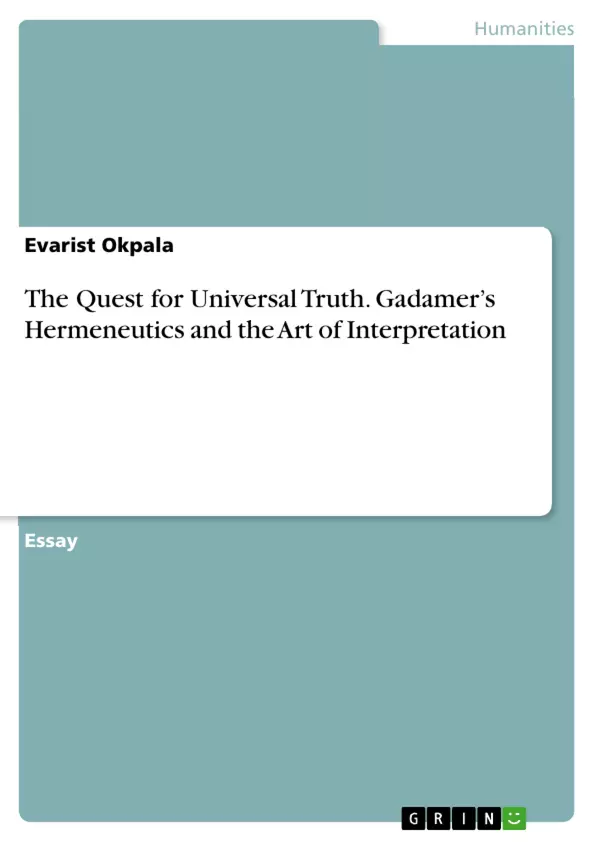Humanity’s perpetual quest for truth is deeply intertwined with the rational interpretation of the world and its phenomena. Despite sharing a universal rationality, individuals often derive conflicting interpretations of the same phenomena, as seen in the divergent views of Africa during colonial times or the multifaceted readings of the Christian Bible. This essay explores the tension between the pursuit of universal truth and the multiplicity of interpretations shaped by historical, cultural, and linguistic contexts. It introduces Hans-Georg Gadamer’s "Truth and Method" as a cornerstone of philosophical hermeneutics, emphasizing the need for dialogue and holistic understanding in the interpretative process. Gadamer’s approach advocates bridging cultural and intellectual divides to enrich comprehension and foster mutual respect. This perspective challenges reductionist and ethnocentric readings of the world, proposing that true understanding arises from engaging with diverse viewpoints in a spirit of open dialogue.
Inhaltsverzeichnis (Table of Contents)
- Introduction
- A look at hermeneutics in general
- Gadamer's philosophical hermeneutics as articulated in Truth and Method
Zielsetzung und Themenschwerpunkte (Objectives and Key Themes)
This text aims to explore Gadamer's philosophical hermeneutics as presented in his work, "Truth and Method," focusing on its implications for understanding truth and interpretation. It examines the historical context of hermeneutics, Gadamer's key contributions, and the significance of his approach for bridging cultural and historical divides.
- The evolution and philosophical development of hermeneutics.
- Gadamer's critique of purely rationalistic approaches to understanding.
- The role of language, history, and culture in interpretation.
- The concept of the "hermeneutic circle" and its implications.
- The importance of dialogue and understanding in arriving at truth.
Zusammenfassung der Kapitel (Chapter Summaries)
Introduction: This introduction establishes the central theme of the text: humanity's persistent quest for truth and the challenges of achieving universally applicable knowledge. It highlights the complexities of interpretation, using examples of contrasting interpretations of African societies, and introduces Gadamer's philosophical hermeneutics as a potential framework for resolving these interpretive conflicts. The introduction emphasizes the need for a holistic approach to understanding, incorporating historical, linguistic, and cultural contexts, advocating for dialogue and mutual respect in the pursuit of truth. The author establishes the relevance of Gadamer’s work in addressing conflicting interpretations and promoting a more inclusive understanding across different perspectives.
A look at hermeneutics in general: This section provides a historical overview of hermeneutics, tracing its origins in ancient Greece and its evolution within Christian traditions. It clarifies hermeneutics as both an act of translation and a deeper process of uncovering hidden meanings and understanding existential, cultural, and historical realities. The chapter emphasizes that hermeneutics is not merely a textual exercise but an existential process of listening and questioning, crucial for genuine understanding, unlike the imposition of external frameworks illustrated by Lord Lugard's interpretation of African societies.
Gadamer's philosophical hermeneutics as articulated in Truth and Method: This chapter delves into Gadamer's major contributions to philosophical hermeneutics, highlighting his emphasis on humanism and the limitations of purely scientific approaches to knowledge. It discusses Gadamer's belief that true understanding requires a holistic approach, encompassing historical, cultural, and linguistic contexts. The section explores the concept of the "hermeneutic circle," where understanding moves from the whole to the parts and back again, crucial for avoiding misinterpretations. The chapter also emphasizes Gadamer’s view of language as fundamental to human understanding and his advocacy for dialogue as a crucial means to achieve a shared understanding of the truth.
Schlüsselwörter (Keywords)
Philosophical hermeneutics, Gadamer, Truth and Method, interpretation, understanding, language, history, culture, dialogue, humanism, hermeneutic circle, truth.
Häufig gestellte Fragen
What is the main topic of this text on Gadamer's Philosophical Hermeneutics?
This text provides a comprehensive overview of Gadamer's philosophical hermeneutics, focusing on his major work, "Truth and Method." It explores the evolution of hermeneutics, Gadamer's key ideas about interpretation and understanding, and the significance of his approach for bridging cultural and historical divides.
What are the key themes explored in this text?
The key themes include: the historical development of hermeneutics, Gadamer's critique of rationalistic approaches, the importance of language, history, and culture in interpretation, the concept of the "hermeneutic circle," and the role of dialogue in arriving at truth.
What does the introduction of the text cover?
The introduction establishes the central theme of humanity's quest for truth and the challenges of interpretation. It introduces Gadamer's hermeneutics as a framework for resolving interpretive conflicts and emphasizes the need for a holistic approach to understanding, incorporating historical, linguistic, and cultural contexts.
What is the historical overview of hermeneutics provided in the text?
The text traces the origins of hermeneutics in ancient Greece and its evolution within Christian traditions. It explains hermeneutics as both an act of translation and a process of uncovering hidden meanings and understanding existential, cultural, and historical realities.
What are Gadamer's major contributions to philosophical hermeneutics?
Gadamer emphasized humanism and the limitations of purely scientific approaches to knowledge. He believed that true understanding requires a holistic approach encompassing historical, cultural, and linguistic contexts. He also developed the concept of the "hermeneutic circle" and emphasized the role of language and dialogue in achieving a shared understanding of truth.
What is the "hermeneutic circle" mentioned in the text?
The "hermeneutic circle" is a concept where understanding moves from the whole to the parts and back again. It's a cyclical process essential for avoiding misinterpretations, as understanding of parts is informed by the whole, and understanding of the whole is refined by examining the parts.
What keywords are associated with this text?
The keywords associated with this text are: Philosophical hermeneutics, Gadamer, Truth and Method, interpretation, understanding, language, history, culture, dialogue, humanism, hermeneutic circle, truth.
- Quote paper
- Evarist Okpala (Author), 2024, The Quest for Universal Truth. Gadamer’s Hermeneutics and the Art of Interpretation, Munich, GRIN Verlag, https://www.hausarbeiten.de/document/1516316


